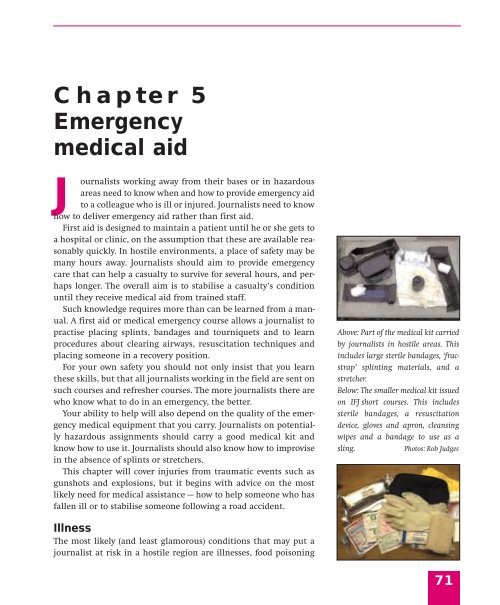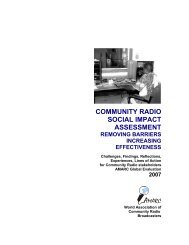Live News - A Survival Guide - International Federation of Journalists
Live News - A Survival Guide - International Federation of Journalists
Live News - A Survival Guide - International Federation of Journalists
- No tags were found...
You also want an ePaper? Increase the reach of your titles
YUMPU automatically turns print PDFs into web optimized ePapers that Google loves.
Chapter 5Emergencymedical aid<strong>Journalists</strong> working away from their bases or in hazardousareas need to know when and how to provide emergency aidto a colleague who is ill or injured. <strong>Journalists</strong> need to knowhow to deliver emergency aid rather than first aid.First aid is designed to maintain a patient until he or she gets toa hospital or clinic, on the assumption that these are available reasonablyquickly. In hostile environments, a place <strong>of</strong> safety may bemany hours away. <strong>Journalists</strong> should aim to provide emergencycare that can help a casualty to survive for several hours, and perhapslonger. The overall aim is to stabilise a casualty’s conditionuntil they receive medical aid from trained staff.Such knowledge requires more than can be learned from a manual.A first aid or medical emergency course allows a journalist topractise placing splints, bandages and tourniquets and to learnprocedures about clearing airways, resuscitation techniques andplacing someone in a recovery position.For your own safety you should not only insist that you learnthese skills, but that all journalists working in the field are sent onsuch courses and refresher courses. The more journalists there arewho know what to do in an emergency, the better.Your ability to help will also depend on the quality <strong>of</strong> the emergencymedical equipment that you carry. <strong>Journalists</strong> on potentiallyhazardous assignments should carry a good medical kit andknow how to use it. <strong>Journalists</strong> should also know how to improvisein the absence <strong>of</strong> splints or stretchers.This chapter will cover injuries from traumatic events such asgunshots and explosions, but it begins with advice on the mostlikely need for medical assistance — how to help someone who hasfallen ill or to stabilise someone following a road accident.Above: Part <strong>of</strong> the medical kit carriedby journalists in hostile areas. Thisincludes large sterile bandages, ‘fracstrap’splinting materials, and astretcher.Below: The smaller medical kit issuedon IFJ short courses. This includessterile bandages, a resuscitationdevice, gloves and apron, cleansingwipes and a bandage to use as asling.Photos: Rob JudgesIllnessThe most likely (and least glamorous) conditions that may put ajournalist at risk in a hostile region are illnesses, food poisoning71
















